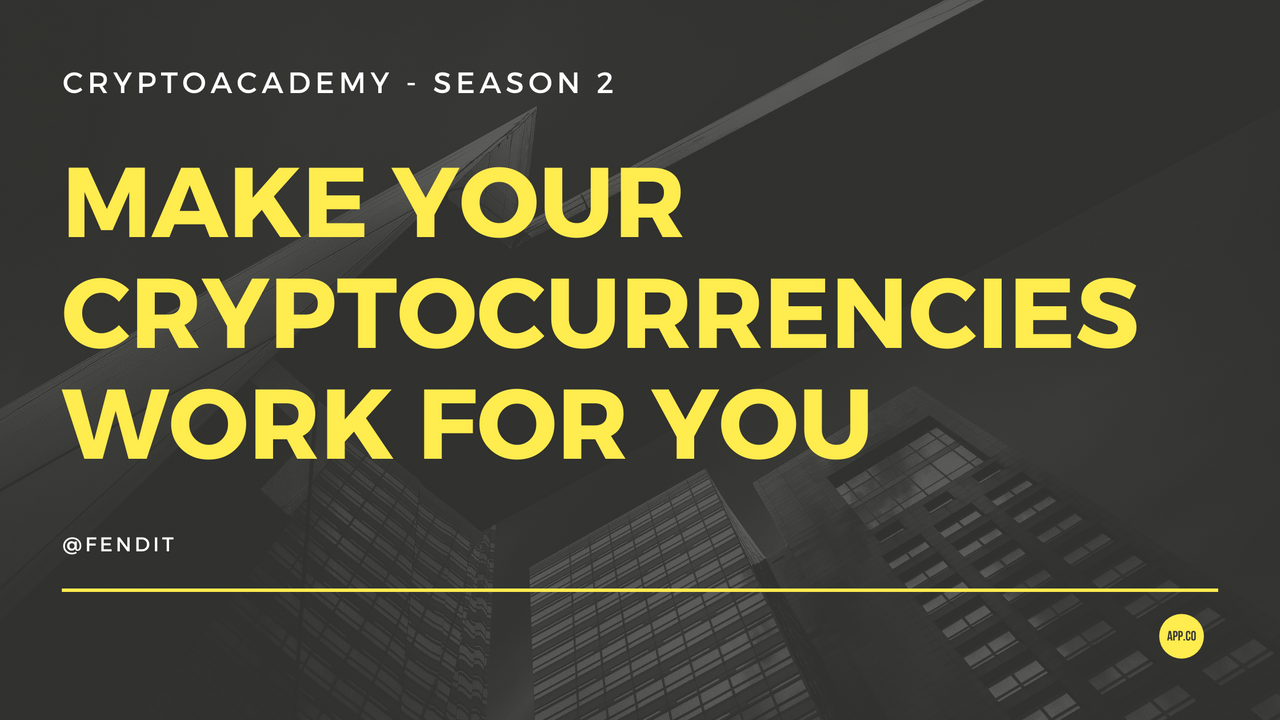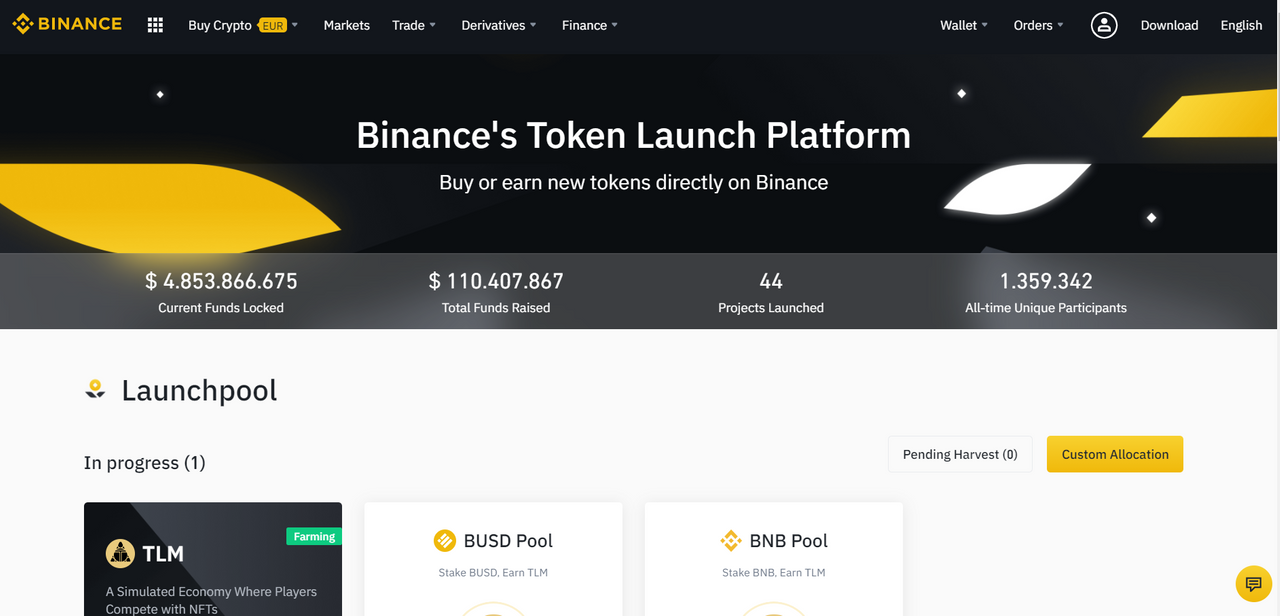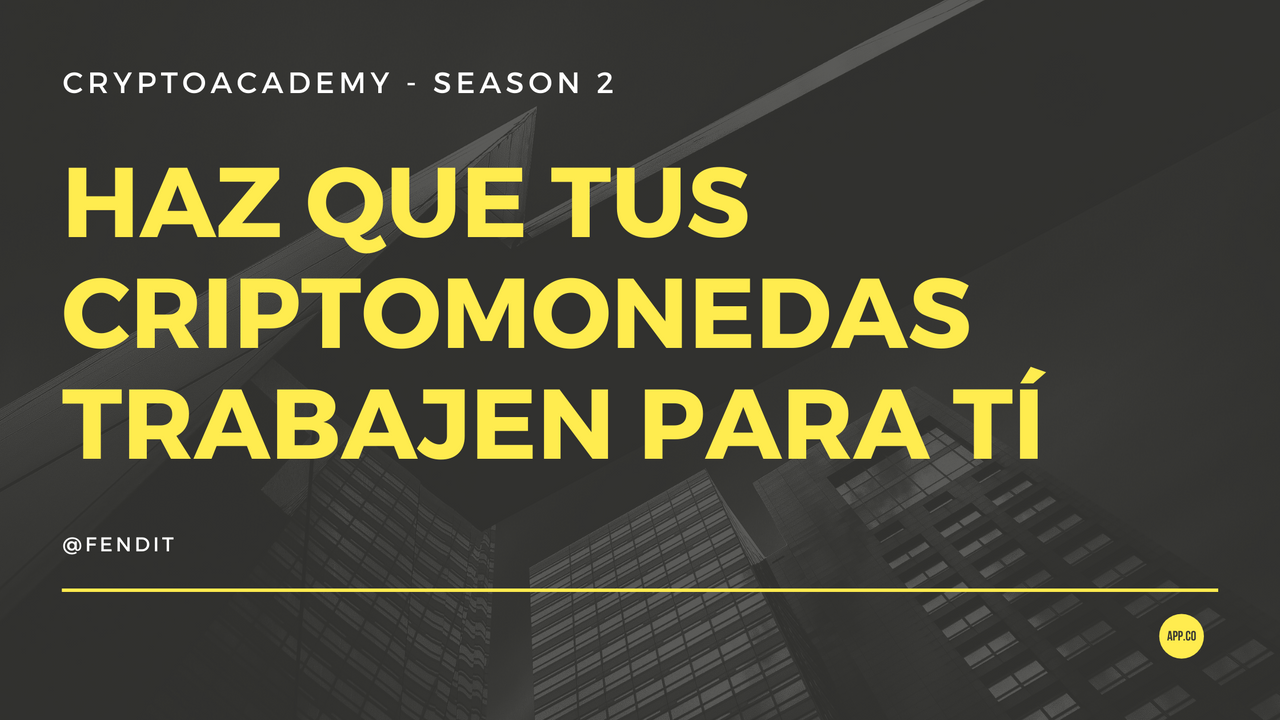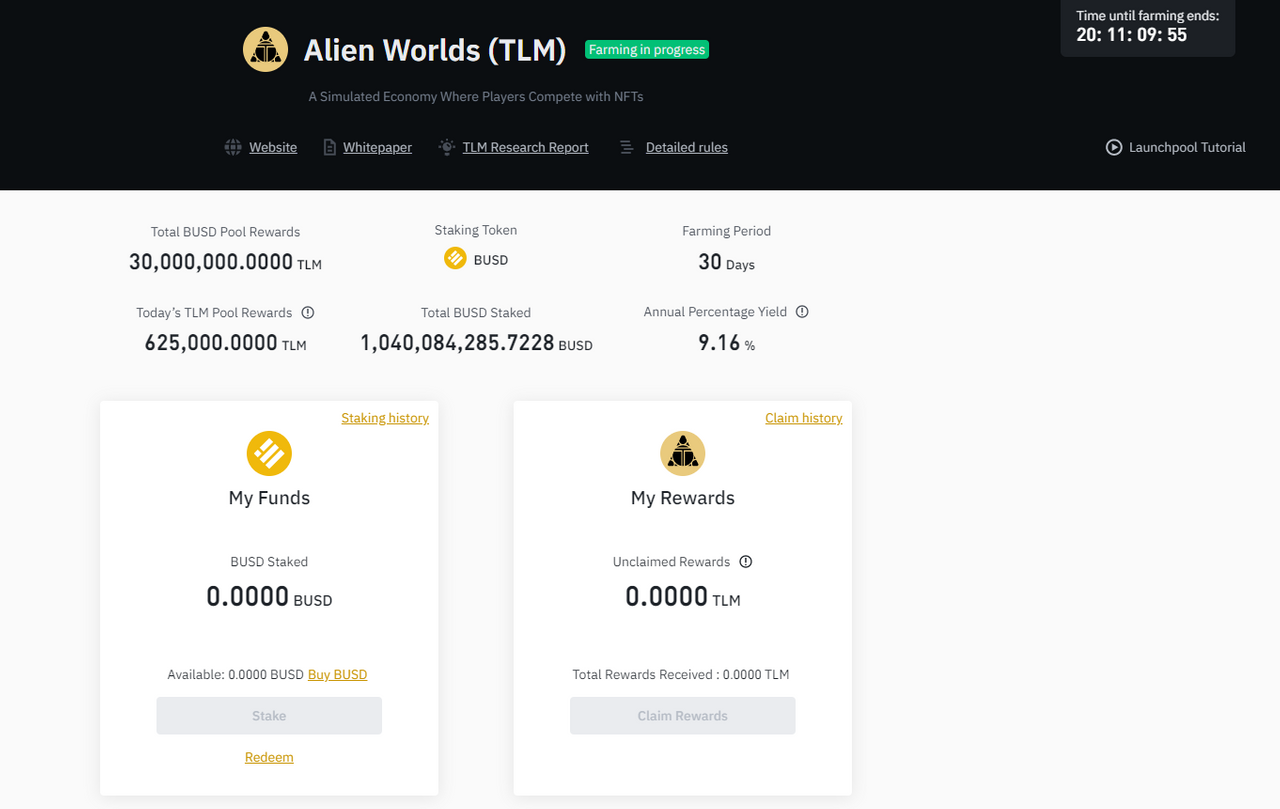
CryptoAcademy - Season 2, Week 2
Make your cryptocurrencies work for you: Binance
Main guideline for this lecture:
- Introduction and aversion to risk
- Token launch
- Staking: Fixed & flexible savings
- High-risk products

Introduction
So, you already have your coins, you feel confident enough to start trading and you're all set up to get lost into this cryptoworld But what now? Is there anything else you can do?
You can make your coins work for you.
This time, I'll show you what you can do with Binance to make the most out of your coins. At first, it's important that you're aware of what type of risk you're willing to assume. Some of these products have very low-risk, but there are others that can make you lose money if you're not using them properly.
How's your aversion to risk?
Your aversion to risk will be determined by how comfortable you feel with uncertainty. Of course, none of us have a magic ball to know what's going to happen or which investment will be the one that gives us the most profit, but still, you can find different options that can make you feel confident enough.
Conservative tolerance to risk: This type of investors are willing to tolerate very low volatility and feel more confident going for investments that give a guaranteed profit.
Moderate tolerance to risk: This type of investors do accept a higher amount of risk and volatility in the assets they invest.
Aggresive risk tolerance: This type of investors are the ones that accept the most volatility of all. They get a very high return, by exposing to very very risky investments.
Always bear in mind this golden rule:
The higher the risk, the maximum return you get. But also, the higher the risk, the higher the loss.
Once you've figured this out... What options does Binance give you?
Token Launch
Binance has this particular platform in which new projects are advertised, as a way of helping them to promote this idea, get liquidity and, afterwards, get their token distributed among the ones that took part in this pool.

What does this mean? Whenever there's a new project, you will be able to stake your own coins to provide liquidity and, once the farming time has ended, you will get your tokens back and this new token that you've farmed. Interesting, right?
You need to get to the Binance's Token Launch Platform, which can be found in the menu (the square that's in the left, on the upper menu!). Once you get there, you will see all the projects that are in progress right now. If you click on any of them, you will see a detail of what the project's about, when the farming will end and which tokens can be staked in that pool. As we're in Binance, 90% of the time you will be asked to stake BUSD (Binance's stablecoin) and BNB, also there can be a third option which can change.
It also gives you more information, such as: the total amount of this new token that will be distributed, total amount of coins being staked, APY (annual percentage yield, which helps you compare which investment will give you a higher return) and total amount of days in which the farming will take place.
If all this information looks good to you, you only need to click "Stake" and choose the amount of tokens that you will be staking. After certain amount of time, you will be able to click "Claim Rewards", which can be see on the right, to get that token you've been farming.
It's important to know that once you start staking your tokens, you can't take them out till the farming time is over.
You can also do this kind of things in other pooling platforms such as PancakeSwap or SushiSwap. If you're willing to do so, you need to be really conscious and careful about the project you will be getting into, as it can be a fraud sometimes. By staking into Binance, at least you're confident that this projects are backed up by the exchange.
I have already written a post on how to farm in PancakeSwap, you can take a look at it here!
Staking: Fixed & flexible savings
If you're not interested in providing liquidity to other pool, but you still want to make the most out of your coins, Binance has something else to offer you.
You can also stake your coins into two different savings. Staking means that you will receive a passive income for those coins that you had in your wallet, but you will have them locked for certain amount of time.
You can find these options here:
 Screen taken from Binance.com
Screen taken from Binance.com
Flexible savings
 Screen taken from Binance.com
Screen taken from Binance.com
The main idea of flexible savings is that you can stake your own coins and take them out in any moment you want. While being staked, your coins will be generating a passive income that sounds a lot more interesting than having them on hold in your wallet, right?
Of course, as you can redeem them in any moment, the APY/interest rate is way lower than in fixed savings, but this is a great choice for you if your risk tolerance is low.
Fixed savings
 Screen taken from Binance.com
Screen taken from Binance.com
On the other hand, if you're a bit more moderate when it comes to risk tolerance, you can think of fixed savings as a great alternative for you. As the term says, you will have your coins staked for a fixed amount of time and you can't take them out.
Interest rates are higher, as you're facing a riskier investment than the previous one, and Binance has different options to choose from: 7, 14, 30, 60 or 90 days. APY increases as you stake them for longer periods of time, but this will also change regarding the choin you're staking.
What should I take into account?
Once you're staking your coins, as they're "locked" let's say, you can't operate with them. This means that you won't be able to sell them or even set a stop loss, so please, bear that in mind before staking.
There are other platforms that offer higher APYs than Binance, but before sending in your coins, make sure that it's a safe place (there have been plenty of scams with all that...) and you should also be aware of the comissions that Binance will charge you for transfering coins to other exchange.
High-risk products
As the name says, you will only want to get into this type of investments if your tolerance to risk is high.
 Screen taken from Binance.com
Screen taken from Binance.com
Dual Investments
In this type of investment, you will deposit a coin and in return, you will receive a yield that's based on two cyptocurrencies. There's a fixed APY, but the return you receive is not only determined by the settlement price (which is the value of the coin you staked at the expiry date) but also, the strike price (which is the target price that you set for your currency, that will determine in which currency you earn your returns).
It's considered a high risk product as the market is really volatile and there are two assets that take part in your investment.
As this is somehow hard to explain, let's go for a demonstration:
I chose to invest 1 BTC in this type of product, at a 50% APY for 30 days. I say that BTC's value in a month will be USD 80K. As this is dual, cause it involves two different currencies, let's say that the other one is USDT.
Once that month is over, we have two different scenarios:
BTC's price was above $80.000
I will get in return: 1 BTC worth in USDT and the interest in USDT.
(80,000 * 0.50) / 365 * 30 = 3.287 USDT
By the end on that month, I will have received 80.000 USDT + 3.287 USDT = 83.287 USDTBTC's price was below $80.000
I will get my BTC back and the yield that I had settled for, in BTC.
(1 * 0.50) / 365 * 30 = 0.041 BTC
By the end on that month, I will have received 1.041 BTC

Homework
Homework for this task will be:
Write a post explaining:
a) Which is your risk aversion, which of these products you find the most appealing and why
b) Explain in your own words fixed and flexible savings, high risk products and launch pools
c) Show and give detail on how to set the investment you chose in Binance. If you don't use Binance as your exchange, let us know which alternatives you have in your own exchange and simulate the process of investing in Binance.
Guidelines
- Your article should be at least 300 words
- Plagiarism won't be tolerated. Don't rush to submit your task and be very detail oriented.
- Tasks will be accepted till 25th April 2021.
- Don't forget to include the following tags #fendit-s2week2 and #cryptoacademy among the first five tags you include.
- Leave a link in the comments of your completed task.

{Traducción al español}

CryptoAcademy - Temporada 2, Semana 2
Haz que tus criptomonedas trabajen para tí: Binance
Guías de esta clase:
- Introducción y aversión al riesgo
- Lanzamiento de tokens
- Staking: Ahorros fijos y flexibles
- Productos de alto riesgo

Introducción
Ya tienes tus monedas, te sientes lo suficientemente seguro para comenzar a hacer trading y estás listo para perderte en este criptomundo. Ahora, qué más puedes hacer?
Puedes hacer que tus criptomonedsa trabajen para tí.
Esta vez les mostraré qué es lo que tiene Binance para ofrecernos. En primer lugar, es importante que sepas qué tipo de aversión al riesgo estás dispuesto a asumir. Alguno de estos productos tienen poco riesgo, pero hay otros que pueden hacerte perder dinero si no comprendes cómo se utilizan.
Cuál es tu aversión al riesgo?
Tu aversión al riesgo estará determinada por qué tan cómodo te sientas con la incertidumbre. Por supuesto, ninguno de nosotros tiene la bola mágica, por lo que no sabemos qué inversión será mejor que la otra, pero aún así tienes diferentes opciones con las que sentirte cómodo.
Conservador: Este tipo de inversor tiene muy poca tolerancia al riesgo y a la volatilidad. Prefiere inversiones cuyo rendimiento esté asegurado y no exponer demasiado sus activos a las fluctuaciones.
Moderado: Este tipo de inversor tiene cierto nivel de tolerancia al riesgo y a la volatilidad, pero no en demasía.
Agresivo: Este tipo de inversor es el que acepta el mayor nivel de volatilidad. Obtienen rendimientos bastante altos, pero también se exponen a pérdidas bastante importantes.
Siempre ten en cuenta esta regla:
A mayor nivel de riesgo, mayor es el rendimiento que obtienes. Pero también, a mayor nivel de riesgo, mayor puede llegar a ser la pérdida.
Una vez que tienes esto en claro... qué opciones tiene Binance para ofrecerte?
Lanzamiento de tokens
Binance tiene una plataforma en particular que publica proyectos nuevos que se están gestando, con la finalidad de poder promocionarlos, que obtengan mayor liquidez para seguir con el desarrollo y, posteriormente, poder distribuir los tokens entre quienes hayan participado de ese pool.

Qué significa esto? Que cuando lancen un proyecto nuevo, tendrás la posibilidad de hacer staking de tus propias monedas para aportar de liquidez a ese fondo y, una vez que el periodo de farmeo haya terminado, obtendrás de vuelta tus tokens y el token por el cual aportaste. Interesante, verdad?
Necesitas ingresar en la plataforma de Binance de lanzamiento de proyectos, la cual puedes encontrarla en el menú (el cuadrado que se encuentra a la izquierda en la barra superior). Una vez que ingreses, verás todos los proyectos que se encuentran en desarrollo ahora. También, podrás encontrar información relevante al respecto, como un mayor detalle del proyecto en sí, cuántos días de farmeo quedan, tiempo total de farmeo, cuáles son los tokens que puedes stakear y cuántos tokens se distribuirán. Como estamos en Binance, el 90% de las veces se pide que se stakeen BUSD (que es la stablecoin de Binance) y BNB, pero también puede sumarse una tercera alternativa.
Si todo esta información te parece bien, sólo necesitas clickear en "Stake" y seleccionar el monto que desees ingresar. Luego de cierto tiempo, podrás cobrar tus recompensas, dandole click a "claim rewards", que se encuentra en el botón a la derecha.
Siempre ten en cuenta que una vez que stakees tus monedas en este pool, se encontrarán bloqueadas hasta que finalice el periodo de farming.
También puedes hacer esto en otras plataformas de pooling, como PancakeSwap o SushiSwap. Si deseas hacerlo, es muy importante que averigues muy bien acerca del proyecto y tengas cuidado, ya que puede ser un fraude. En este caso, al realizarlo a traves de Binance, nos aseguramos que tengan cierta seriedad.
Si deseas farmear tus propias monedas en PancakeSwap, aquí dejo una publicación que ya escribí al respecto!!
Staking: Ahorros fijos y flexibles
Si no estás interesado en proveer de liquidez a un proyecto, pero aún así quieres obtener rendimientos de tus monedas, Binance también tiene algo para ofrecerte.
Puedes stakear tus monedas en dos tipos de fondos diferentes. Hacer staking significa dejar tus monedas "bloqueadas" por cierto tiempo en tu billetera, para obtener luego un rendimiento pasivo por ellas.
Puedes encontrar estas opciones aquí:
 Screen tomado de Binance.com
Screen tomado de Binance.com
Ahorros flexibles
 Screen tomado de Binance.com
Screen tomado de Binance.com
La idea principal de este tipo de ahorros es que puedes bloquear tus monedas en cualquier momento y retirarlas cuando desees. Mientras tus monedas se encuentren stakeadas, generarán un interés pasivo, lo cual suena mucho más interesante que tenerlas paradas en tu billetera, no?
Por supuesto, como puedes retirarlas en cualquier momento, la tasa de retorno será menor a los ahorros fijos, pero es una buena alternativa si tu tolerancia al riesgo es baja.
Ahorros fijos
 Screen tomado de Binance.com
Screen tomado de Binance.com
Por otro lado, si eres un poco más moderado en cuanto al riesgo, puedes pensar en los ahorros fijos como una buena opción. Como el término lo dice, tus monedas estarán stakeadas por un periodo de tiempo determinado y no puedes retirarlas hasta que haya finalizado.
Las tasas de interés son más altas, ya que te enfrentas a una inversión con mayor riesgo a la anterior y Binance tiene distintos plazos para ofrecerte: 7, 14, 30, 60 o 90 días. Obviamente, el retorno será mayor a mayor cantidad de días tengas tus activos stakeados y, también, depende mucho de la moneda que estés stakeando.
Qué más debo tener en cuenta?
Una vez que te encuentres haciendo staking de tus monedas, al estar "bloqueadsa", no podrás operar con ellas. Es decir, no podrás venderlas ni poner un stop loss, por lo que ten mucho cuidado antes de realizar algo.
Hay otras plataformas que te ofrecen tasas de interés superiores a Binance, pero antes de enviar tus monedas a otra billetera asegúrate que sea un lugar seguro y que las comisiones sean convenientes!
Productos de alto riesgo
Como el nombre lo dice, son las inversiones que tienen asociado un riesgo mucho mayor a los anteriores.
 Screen tomado de Binance.com
Screen tomado de Binance.com
Inversiones duales
En este tipo de inversiones, depositarás una moneda y recibirás a cambio un rendimiento que estará basado en dos criptomonedas. Hay una tasa de interés fijada, pero el retorno que recibes no sólo está determinado por la cotización al cierre (es decir, el precio al que cotiza tu moneda stakeada al finalizar el periodo), sino también en el precio objetivo (es decir, el precio al que habías apostado que la moneda cotizaría, esto también determinará en qué moneda cobrarás tu ganancia).
Se considera un producto riesgoso, ya que el mercado de criptomonedas es realmente volátil... imagínate con dos monedas interviniendo.
Como es algo complejo de explicar, vamos con un ejemplo:
Yo elijo invertir 1 BTC en este producto, con un rendimiento del 50% anual por 30 días. Digo también que el BTC, al finalizar ese mes, tendrá un valor de USD 80K. Como es dual, porque intervienen dos monedas, digo que la otra moneda será USDT.
Una vez que ese mes terminó, tenemos dos escenarios diferentes:
- El precio del BTC está por encima de $80.000
Obtendré a cambio: 1 BTC convertido a USDT y el interés pactado en USDT.
(80,000 * 0.50) / 365 * 30 = 3.287 USDT
Al finalizar ese mes, habré obtenido 80.000 USDT + 3.287 USDT = 83.287 USDT
*El precio del BTC se encuentra por debajo de $80.000
Obtendré mi BTC de vuelta y el rendimiento será determinado en BTC
(1 * 0.50) / 365 * 30 = 0.041 BTC
Al finalizar ese mes, habré obtenido 1.041 BTC

Tarea
La tarea para esta clase será:
Redacta una publicación en la que expliques:
a) Cuál es tu aversión al riesgo, qué producto de estos te parece más interesante y por qué?
b) Explica con tus propias palabras los ahorros fijos y flexibles, lanzamiento de tokens y productos de alto riesgo.
c) Muestra y dá detalle de cómo hacer la inversión que elegiste en Binance. Si no utilizas este exchange, averigua en el tuyo qué tipo de inversiones es posible hacer y, también, simula el proceso en Binance.
Reglas
- Tu artículo debe contener, como mínimo, 300 palabras
- NO toleraremos plagio. No te apures a publicar tu tarea, oriéntate al detalle.
- Se aceptarán tareas hasta el 25 de abril de 2021.
- Entre las primeras cinco etiquetas, no olvides incluir las siguientes: #fendit-s2week2 y #cryptoacademy
- Deja el link de tu tarea en un comentario en esta publicación!

Cc.
@steemitblog
@steemcurator01
@steemcurator02


